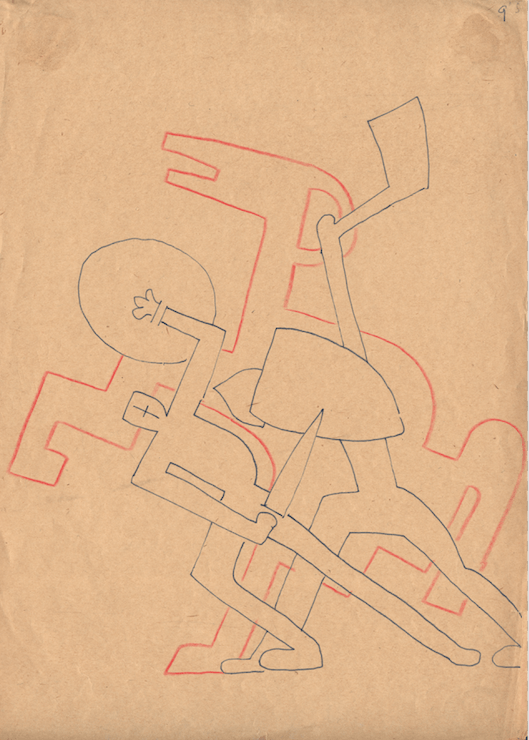"From drawing, via the theatre, to the cinema". Naum Kleiman's introductory qualification of Sergey Eisenstein's own self-perceived line in his Film Form is one that he follows in a necessarily selective and well-organised biography of the director as graphic artist, acompanied by over 500 previously unpublished illustrations.
We follow the phenomenon from the young fantasist of Riga, anthropomorphising creatures as society eccentrics, though stage designs indebted to Meyerhold's example - what one wouldn't give to see realisations of his sets and costumes for Shaw's Heartbreak House and Offenbach's The Tales of Hoffmann - and on to the revealing sketches for Alexander Nevsky and Ivan the Terrible, with a coda outlining Eisenstein's leaning towards choreography on the eve of his untimely death on 11 February 1948, less than a month after his 50th birthday.
 But there's so much between the lines that defies categorisation - those flowing, Matisse-like reductions of form which the master described as "emotional hieroglyphs of pre-cognition". He knew that often these were far from the work of a master draughtsman; rather they were like the offspring "of a fruit fly, that reproduces 12 times a year (?)"; they are "impulsive, sensuous, instinctive," complementing the conscious mastery of the finished cinematic masterpieces.
But there's so much between the lines that defies categorisation - those flowing, Matisse-like reductions of form which the master described as "emotional hieroglyphs of pre-cognition". He knew that often these were far from the work of a master draughtsman; rather they were like the offspring "of a fruit fly, that reproduces 12 times a year (?)"; they are "impulsive, sensuous, instinctive," complementing the conscious mastery of the finished cinematic masterpieces.
The subjects are telling - religious, mythological, selectively dramatic (why the obsession with Macbeth's murder of King Duncan, one wonders, looking at one of the finest series reproduced here - one seen on the front cover pictured above?) And as well as the film sketches - none, incidentally, for the silent masterpieces, which means a gap of eight years in the visual biography - there are side-works. Eisenstein's regular use of telling red lines visualises the musical dimension in the Moscow decade, revelatory in a sequence devoted to Alexander Nevsky's Battle on the Ice, where we "see" the impact of Prokofiev's music in his colleague's pencil artistic strokes (an example pictured below).
 Curiously the only element missing here is the phallocentric, probably because a selection of Eisenstein's erotic drawings has already appeared in print (as Dessins Secrets). There's not an erect penis in sight, and Kleiman rather glides over the issue of homoeroticism in the allegedly bisexual Eisenstein's work (though not his identification with "man, woman and child" represented in single figures). Even so, it is up to us to make what we will of that final, numinous appearance of the Diaghilev/Debussy/Nijinsky Faun transfigured in the "Afterword".
Curiously the only element missing here is the phallocentric, probably because a selection of Eisenstein's erotic drawings has already appeared in print (as Dessins Secrets). There's not an erect penis in sight, and Kleiman rather glides over the issue of homoeroticism in the allegedly bisexual Eisenstein's work (though not his identification with "man, woman and child" represented in single figures). Even so, it is up to us to make what we will of that final, numinous appearance of the Diaghilev/Debussy/Nijinsky Faun transfigured in the "Afterword".
Kleiman has his own theories on its significance, which get a bit out of hand at the end. Still, better that than no sense of style, and no matter when it comes to the look of the thing. Beautifully produced, with admirable support from the perfectionist Kino Klassika foundation which brought us one of the live highlights of the year, October accompanied by an imaginative reconstruction of Edmund Meisel's original score, this is a work of art in itself to set alongside Eisenstein's major achievements.
- Naum Kleiman: Eisenstein on Paper: Graphic Works by the Master of Film (Thames and Hudson, £60)
- More book reviews on theartsdesk















Add comment